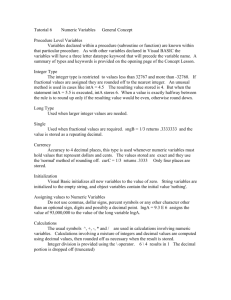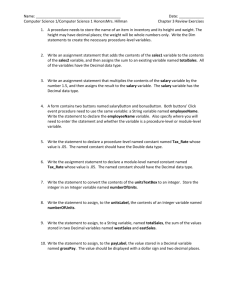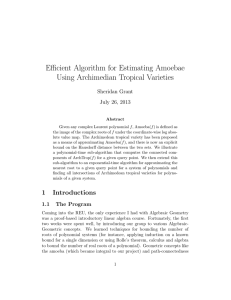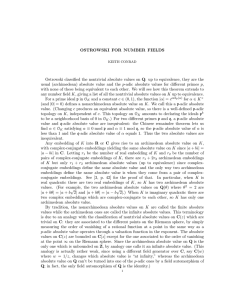about numbers.
advertisement
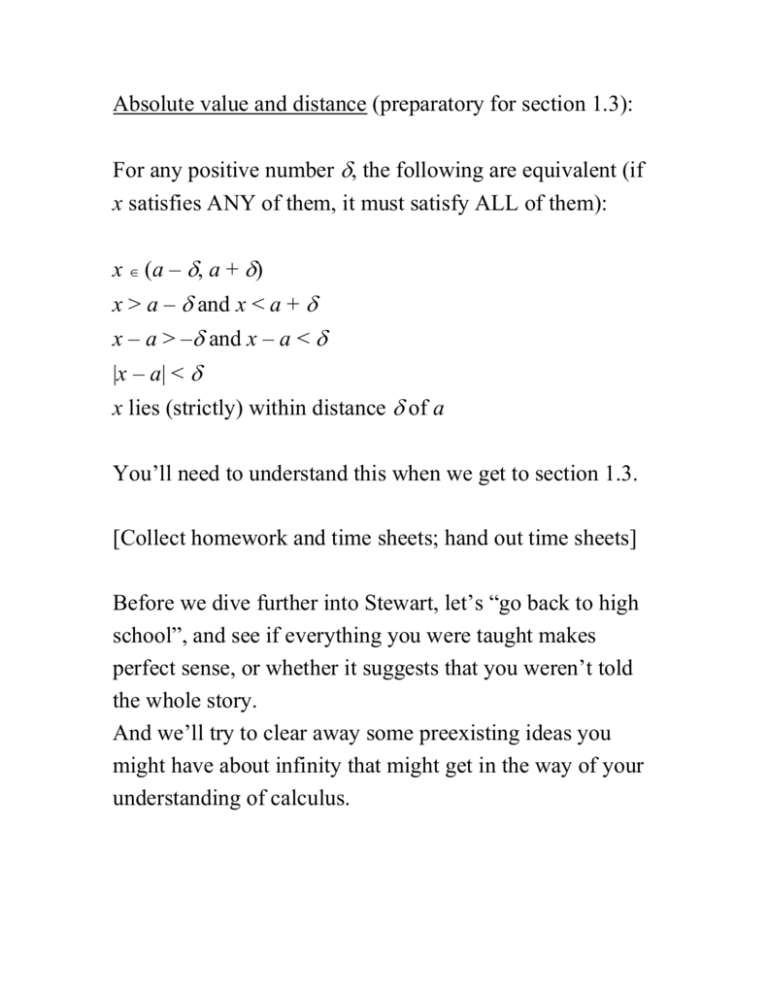
Absolute value and distance (preparatory for section 1.3): For any positive number , the following are equivalent (if x satisfies ANY of them, it must satisfy ALL of them): x (a – , a + ) x > a – and x < a + x – a > – and x – a < |x – a| < x lies (strictly) within distance of a You’ll need to understand this when we get to section 1.3. [Collect homework and time sheets; hand out time sheets] Before we dive further into Stewart, let’s “go back to high school”, and see if everything you were taught makes perfect sense, or whether it suggests that you weren’t told the whole story. And we’ll try to clear away some preexisting ideas you might have about infinity that might get in the way of your understanding of calculus. Does there exist an integer that is bigger than every real number? ..?.. ..?.. Does there exist a real number that is bigger than every integer? ..?.. ..?.. Archimedean Property: For every real number x, there exists an integer N greater than x. If you assume that real numbers and integers have decimal expansions, this is a theorem. But if you start out with the high school axioms for the real numbers, the Archimedean Property can’t be proved from the algebraic formulas that +, , , satisfy; it has to be assumed as an extra axiom, called the Archimedean Axiom. If you believe the high school axioms (for instance, every positive number has a reciprocal that is also positive), and you believe the Archimedean Axiom, then you must also believe that for every positive real number , however small, there exists a positive integer N such that 1/N < . Why? ..?.. ..?.. Given > 0, let x = 1/; by the Archimedean Property, there exists a positive integer N with N > 1/, so … ..?.. ..?.. taking the reciprocals of both sides (and using the fact that both numbers are positive), we get 1/N < . We’ll see shortly that this has some important consequences. Is 0.999… the same as 1.000…? Why or why not? ..?.. ..?.. [Have students discuss this.] Intuitively, it seems to many students that since 0.9 < 1.0, and 0.99 < 1.00, and 0.999 < 1.000, and similarly for finite decimals of arbitrary length (no matter how large), the “<” should stay a “<” (and not become an “=”) when we replace a long finite string of 9’s by a string of infinitely many 9’s. But if we insist on having 0.999… and 1.000… represent two different numbers, we’re going to have to sacrifice some of the rules of algebra. Here’s one reason why: Let x = 0.999… Then 10x = ..?.. ..?.. 9.999…, and if we subtract the first equation from the second, we get ..?.. ..?.. 9x = 9.000…, so x = 1.000. Here’s another reason why: Let d = 1.000… – 0.999… It’s easy to see that d is less than 1/10, 1/100, 1/1000, etc. So if d isn’t 0, it’s a positive number that’s less than 1/n for every positive integer n. Could such a thing exist? ..?.. ..?.. Nope; we proved this as a consequence of the Archimedean Property. In the set of real numbers, which I’ll write as R, there is no number “infinity”; and the number 1.000… – 0.999… is not infinitesimal, but simply 0. That is, 1.000… and 0.999… are two different names for the same number. “Could 0.999… be the real number immediately to the left of 1.000… on the number line?” ..?.. ..?.. Is there such a thing as “the number immediately to the left of 1?” ..?.. ..?.. If there were such a thing as two real numbers x, y being consecutive on the number line, where would their average (x+y)/2 go on the number line?! If 0.999… and 1.000… were two different numbers, what would the decimal expansion of their average be?! There’s still something unsatisfying to me about the above explanation, because it doesn’t really address the question “What do infinite decimals (like .999…) mean?” A terminating decimal like 3.1415 has a clear meaning (3.1415 is the rational number 31415/10000), but how are we to understand something like 3.1415… (the decimal expansion of )? Let’s go back to the first useful infinite decimal you learned about: 1/3 = .333… It arises from doing long division. That is, 1/3 is bigger than .3 (but less than .4), it’s bigger than .33 (but less than .34), etc. [Sketch it.] So .333… can be seen as the ADDRESS of 1/3 on the decimal number-line. The terminating decimals are the landmarks that help us find the non-terminating decimals as we zoom in. (Later we’ll learn to interpret .333… as the sum of the infinite series 3/10 + 3/100 + 3/1000 + ..., but we won’t learn how to add infinitely many numbers together until next semester.) So, .333… means “The real number that’s between .3 and .4, between .33 and .34, between .333 and .334, etc.” Or: “The real number that lies in all the intervals [.3,.4], [.33,.34], [.333,.334],...” Or: “The real number that lies in the intersection of the intervals [.3,.4], [.33,.34], [.333,.334],...” Could there room for TWO real numbers in the intersection of those intervals? How small would the difference between the two numbers be? ..?.. ..?.. Less than 1/10, less than 1/100, less than 1/1000, ... Are there any positive real numbers less than 1/10n for all n? ..?.. ..?.. Nope, by the Archimedean Property. Summary: Every infinite decimal corresponds to one and only one real number, but some real numbers have TWO decimal expansion: one that ends in infinitely many 0’s (like 1/2 = .5000…) and one that ends in infinitely many 9’s (like 1/2 = .4999…). “Most” rational numbers (like 1/3), and all irrational numbers, have just one decimal expansion. Note: If you find the Archimedean Axiom dissatisfying, you may be pleased to know that you're in good company. Lots of mathematicians have wanted to have infinite and infinitesimal numbers to play with (going back to Leibniz), and there are number systems in which the Archimedean Axiom is false! And such number systems (called “non-standard real number systems”) are even useful. But in this class we’ll stick with the ordinary real numbers. One reason is, they’re easier to work with. Another reason is that, every nonstandard number system contains the ordinary real number system as a subsystem. Just as the integers sit inside the real numbers, and you can round real numbers to the nearest integer, the real numbers sit inside the non-standard real numbers, and you can round each non-standard real number to the nearest real number. For instance, even in number systems where you might have a number infinitesimally close to 1, its standard part would still be 1. So there’s really no avoiding the standard picture of what real numbers are. In this class there’ll be no infinitesimal numbers (and no infinite numbers either). We may use the word “infinity” to signify a direction on the number line, but it’s a direction, not a destination, and not a number.



